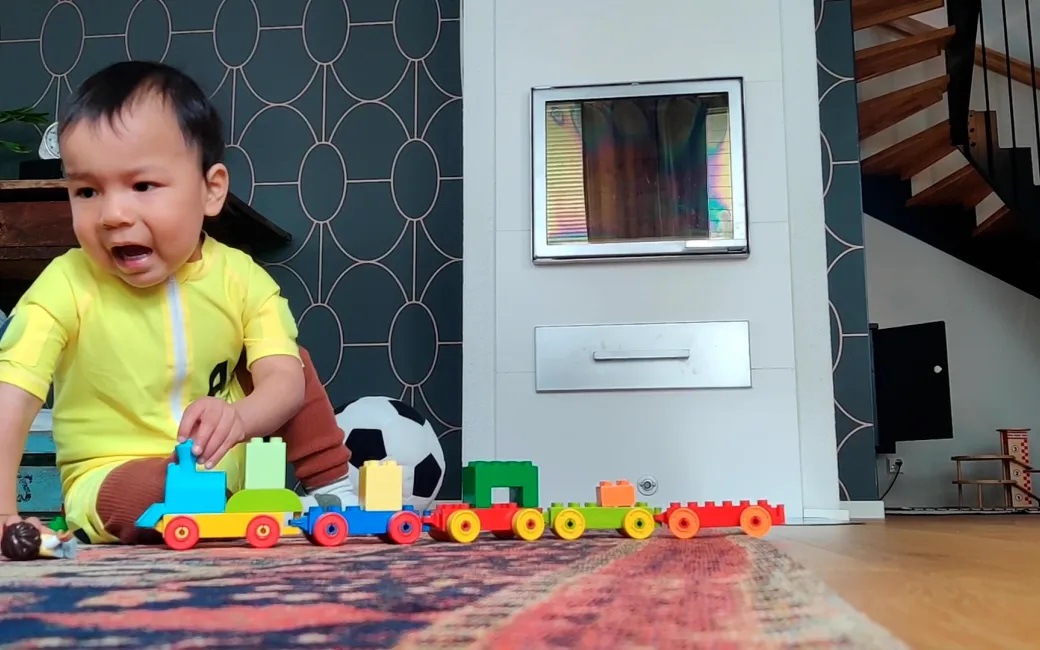A smart jumpsuit tracks infants’ motor development

Movesense sensor allows researchers to create a new method for assessing the neurological development of young children. Early motor assessment is essential for supporting the early detection of neurodevelopmental problems and their therapeutic interventions.
Photo: Helsinki University
A Finnish research group at the BABA Center, Helsinki Children’s Hospital, has developed a novel wearable for infants for the reliable assessment of motor abilities during early development. The smart jumpsuit MAIJU (Motor Assessment of Infants with a Jumpsuit) is a wearable medical device equipped with multiple Movesense sensors, which assist in assessing and predicting children’s neurological development.
In their recent study, the scientists measured infants at 5 to 19 months of age using the MAIJU jumpsuit during spontaneous playtime, mostly in the children’s own home environment. In the beginning of the study, the postures and movements of the infants were identified visually from a video recording using a motility description scheme custom developed for this study. This information was then used to train a machine learning algorithm to recognize the same postures and movements for every second of each child’s playtime. The recognition accuracy equaled visual assessment by a trained expert.
— The development of the MAIJU wearable required a technical breakthrough in the development of machine learning algorithms for this purpose. We achieved this by combining a new kind of motility description with state-of-the-art deep learning solutions, states the leader of technical development, Dr Manu Airaksinen.
New methods for studying neurological development
The MAIJU jumpsuit and the associated analytical solutions allow both the assessment and tracking of child’s motor maturation at an unprecedented accuracy. This advance can be exploited in many ways, for instance in early clinical diagnostics and other developmental assessments. It also makes it possible to measure efficacy in various kinds of medical treatments and therapies.
— Our research shows that it is very possible to assess the motor development of an infant outside of a hospital or special laboratory setting. A particular advantage of the MAIJU methodology is the fact that it allows us to carry out developmental assessments in the natural environment of the child, such as a home or daycare, explains Sampsa Vanhatalo, professor in physiology and the leader of the BABA Center.
— Methods of this kind are urgently needed to support the research and novel therapeutic innovations of early neurological development, confirms Leena Haataja, professor in child neurology.
The earlier neurodevelopmental delays and related challenges are identified, the better we can support the child’s upcoming development and lifelong neurocognitive performance.
Children move to learn
It is now commonly accepted that the motor development of a young child is not independent of all other neurocognitive development. The strong innate drive of the child to move has emerged from a clear need: the child must move a lot to gain experience and learn from the surrounding environment.
— It is therefore important to encourage children to move as naturally and as much as possible in everyday life, says Haataja.
A child with motor or other neurological challenges will need special support or therapies. These work best if they are part of the child’s daily life and environment. The MAIJU smart jumpsuit helps to find better therapeutic strategies in such situations and to assess the efficacy of such therapies.
New applications for wearables
Developing a smart wearable for medical use is many times harder than bringing a consumer product to the market. Vanhatalo believes that their successful work in wearable development has extensive global impact and a bright future.
— Our methods can be automatized and scaled up for very wide use. It is also possible that our technology could be adapted for developing wearable solutions to help other patient groups, such as older children or even elderly people.
Movesense sensor lowers the barrier of developing new wearable solutions for both medical and non-medical use. At Movesense, we are proud and excited that our technology has made this breakthrough project possible. We are looking forward to see the next steps!
Another key tool the project was Kaasa Data Collector, an app developed by Kaasa solution GmbH for collecting and managing Movesense sensor data in research and development projects. Movesense sensor and Kaasa Data Collector are available to all researchers and product innovators.
Text based on a press release of Helsinki University.
More information
To discuss about using Movesense sensor in your own project or product:
Original article in Nature Communications Medicine:
Airaksinen, M., Gallen, A., Kivi, A., Vijayakrishnan, P., Häyrinen, T., Ilén, E., Räsänen, O., Haataja, L., Vanhatalo, S. Intelligent wearable allows out-of-the-lab tracking of developing motor abilities in infants. Commun. Med. 2022. DOI: 10.1038/s43856-022-00131-6
Views: 201
